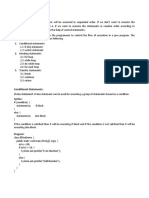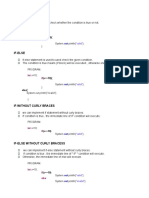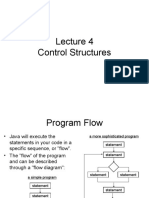1.
if statement
if is keyword used to write condition.
Syntax :
if(condition){
stmts;
}
�//write a program to check a number and print if it is positive
class IfStatement {
public static void main(String[] args) {
int number = 10;
// checks if number is greater than 0
if (number > 0) {
System.out.println("The number is positive.");
System.out.println("Statement outside if block");
}
�2.if else
if else are keywords used to write condition
syntax :
if(condition){
stmt 1;
else{
stmt 2;
}
�Flowchart :
�//write a program to check a number and print if it is positive or negative
class Main {
public static void main(String[] args) {
int number = -10;
// checks if number is greater than 0
if (number > 0) {
System.out.println("The number is positive.");
// execute this block
// if number is not greater than 0
else {
System.out.println("The number is not positive.");
System.out.println("Statement outside if...else block");
}
�3. else if ladder
To write more than one condition and only one condition should be executed then we use
else if ladder.
Syntax :
if(condition){
else if{
else if{
else{
}
�// write a program to take a value from user and print wheather it is positive/negative/zero
class Main {
public static void main(String[] args) {
int number = 0;
// checks if number is greater than 0
if (number > 0) {
System.out.println("The number is positive.");
// checks if number is less than 0
else if (number < 0) {
System.out.println("The number is negative.");
// if both condition is false
else {
System.out.println("The number is 0.");
}
�4. Switch :
syntax :
switch(condition){
case 1:
stmts;
break;
case 2:
stmts;
break;
case 3:
stmts;
break;
case n:
stmts;
break;
default:
stmts;
}
�// write a program to take a number from user, and perform operation as per his choice for
arithmetic operations
package basicPrograms;
import java.util.Scanner;
public class SwitchDemo {
public static void main(String[] args) {
int choice, num1=10, num2=5;
Scanner s = new Scanner(System.in);
System.out.println("Please enter your choice");
System.out.println("1. Addition");
System.out.println("2. Substraction");
System.out.println("3. Multiplication");
System.out.println("4. Division");
System.out.println("Please enter choice.");
choice = 3; //3
� switch(choice){
case 1:
System.out.println(num1+num2);
break;
case 2:
System.out.println(num1-num2);
break;
case 3:
System.out.println(num1*num2);
break;
case 4:
System.out.println(num1-num2);
break;
default:
System.out.println("please enter correct choice");
break;
}
�Looping Statements :
To execute some set of code repeatedly we use loops.
while loop :
While is entry controlled loop used to execute some set of code repeatedly.
syntax :
while(condition){
Program : write a program to print numbers from 1 to 100.
package loopPract;
public class WhileDemo {
public static void main(String[] args) {
int i=1;
while(i<=10) {
System.out.println(i);
i++; //11
}
�do while loop :
do while loop is exit control loop.
syntax :
do{
}while(condition);
//program to print numbers from 1 to 10
package loopPract;
public class DoWhileDemo {
public static void main(String[] args) {
int i=1;
do{
System.out.println(i);
i++;
}while(i<=10);
}
��for loop
for loop is used to execute set of statements repeatedly
syntax :
for(initialization;condition;increment/decrement){
//Program 3 : Write a program to print 1 to 100 using for loop
package basicPrograms;
public class ForDemo {
public static void main(String[] args) {
for(int i=1;i<=10;i++) { //1,2,3,4.....9,10,11
System.out.println(i); //1,2,3...9,10
}
}
/*
sequence
step 1 : initialization
step 2 : condition (if condition is true then next steps will be executed)
step 3 : body
step 4 : increment/decrement
step 5 : repeat step 2 to 4 till loop condition is true
*/
�//write a program to print below pattern using nested loop
/*
**
***
****
*****
*/
package loopPract;
public class PatternDemo {
public static void main(String[] args) {
//for lines
for(int i=1;i<=5;i++) { //6
//print
for(int j=1;j<=i;j++) { //
System.out.print(j);
System.out.println();
}}
�for each loop :
It’s commonly used to iterate over an array or a Collections class (eg, ArrayList)
//for…each loop with array :
package basicPrograms;
public class ForEachDemo {
public static void main(String[] args) {
int eids[]= {10,20,30,40};
for(int e : eids) {
System.out.println(e);
}
}
�//for…each loop with arraylist :
package basicPrograms;
import java.util.ArrayList;
public class ForEachDemo {
public static void main(String[] args) {
ArrayList<Integer> eids= new ArrayList();
eids.add(20);
eids.add(30);
eids.add(40);
eids.add(50);
for(int e : eids) {
System.out.println(e);
}























































































